Land Cruiser URJ200 URJ202 GRJ200 VDJ200 - AUDIO / VIDEO
AUDIO AND VISUAL SYSTEM (w/ Navigation System) - SYSTEM DESCRIPTION
| DVD (Digital Versatile Disc) PLAYER OUTLINE |
The DVD player can only play DVD videos that have any of the following marks:

The following products may not be playable on your player.
Precaution for use of discs
- NOTICE:
| CD (Compact Disc) PLAYER OUTLINE |
A compact disc player uses a laser pickup to read digital signals recorded on a CD (compact disc). By converting the digital signals to analog, it can play music and audio.
- CAUTION:
- Do not look directly at the laser pickup because the CD player uses an invisible laser beam. Be sure to operate the player only as instructed.
- NOTICE:
Usable discs
This player can play only audio CDs, CD-Rs (CD-Recordable) and CD-RWs (CD-ReWritable) that have any of the following marks:

Precautions for use of discs
- NOTICE:
- HINT:

Cleaning
- NOTICE:
- Do not use a lens cleaner because it may cause a malfunction in the pickup portion of the player.
If dirt is on the disc surface, wipe it clean with a soft dry cloth such as an eyeglass cleaner for plastic lenses from the inside to the outside in a radial direction.
- NOTICE:
| MP3/WMA OUTLINE |
Playable MP3 file standards
| Compatible standard | MP3 (MPEG1 LAYER3, MPEG2 LSF LAYER3) |
| Compatible sampling frequency | MPEG1 LAYER3: 32, 44.1, 48 (kHz) MPEG2 LSF LAYER3: 16, 22.05, 24 (kHz) |
| Compatible bit rate | MPEG1 LAYER3: 32 to 320 (kbps) MPEG2 LSF LAYER3: 8 to 160 (kbps) Compatible with VBR |
| Compatible channel mode | Stereo, joint stereo, dual channel, monaural |
Playable WMA file standards
| Compatible standard | WMA Ver. 7, 8, 9 |
| Compatible sampling frequency | 32, 44.1, 48 (kHz) |
| Compatible bit rate (Only compatible with 2-channel playback) | Ver. 7, 8: CBR48 to 192 (kbps) Ver. 9: CBR48 to 320 (kbps) |
ID3 tag and WMA tag
Additional text information called an ID3 tag can be input to MP3 files. Information such as song titles and artist names can be stored.
- HINT:
- This player is compatible with ID3 tags of ID3 Ver. 1.0 and 1.1, and ID3 Ver. 2.2 and 2.3 (Number of characters complies with ID3 Ver. 1.0 and 1.1.).
Additional text information called a WMA tag can be input to WMA files. Information such as song titles and artist names can be stored.
Usable media
Only CD-ROMs, CD-Rs (CD-Recordable) and CD-RWs (CD-ReWritable) can be used to play MP3/WMA files.
- NOTICE:
Usable media format
Usable media format
| Disc format | CD-ROM Mode 1, CD-ROM XA Mode 2 Form1 |
| File format | ISO9660 Level 1 and Level 2 (Joliet, Romeo) |
- HINT:
Standards and restrictions
| Maximum directory levels | 8 levels |
| Maximum number of characters for a folder name/file name | 32 characters |
| Maximum number of folders | 192 (Including empty folders, root folders, and folders that do not contain MP3/WMA files) |
| Maximum number of files in a disc | 255 (Including non-MP3/WMA files) |
File names
Only files with an extension of ".mp3" or ".wma" can be recognized and played as MP3 or WMA files.
Save MP3 or WMA files with an extension of ".mp3" or ".wma".
- NOTICE:
- If non-MP3 or non-WMA files are saved with an extension of ".mp3" or ".wma", those files may be wrongly recognized as MP3 or WMA files and played. A loud noise may occur and damage to the speakers may result.
| COMMUNICATION SYSTEM |
MOST Network Outline
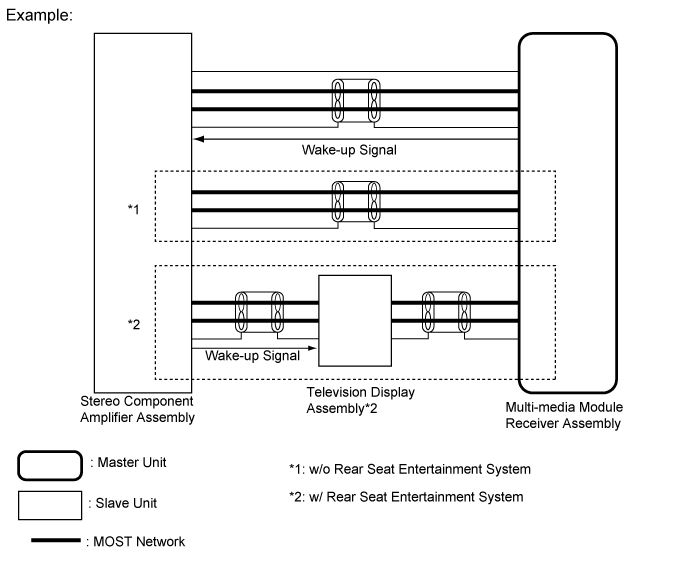
Audio and visual system components communicate with each other via the MOST network.
The MOST network uses a shielded twisted pair of wires for its communication lines.
The master unit of the MOST network is the multi-media module receiver assembly.
MOST communication lines connect each slave unit centering around the master unit to form a MOST network ring.
The master unit sends a wake-up signal to activate each slave unit connected to the MOST network.
- HINT:
- If a short or open circuit occurs in the MOST circuit, communication will be interrupted and the system will not operate normally.
AVC-LAN Outline
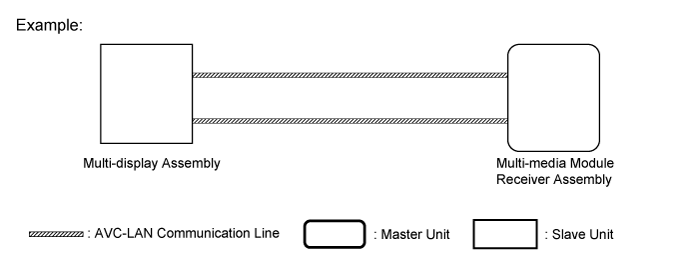
Components of the audio and visual system communicate with each other via the AVC-LAN.
The AVC-LAN uses a twisted pair of wires for its communication lines.
The master unit of the AVC-LAN is the multi-media module receiver assembly.
- HINT:
| DIAGNOSTIC FUNCTION OUTLINE |
The navigation system has a diagnostic function (the result is indicated on the master unit or the intelligent tester).
| "Bluetooth" OUTLINE |
"Bluetooth" is a trademark owned by Bluetooth SIG, Inc.
"Bluetooth" is a wireless connection technology that uses the 2.4 GHz frequency band.
- HINT:
- The communication performance of "Bluetooth" may vary depending on obstructions or radio wave conditions between communication devices, electromagnetic radiation, communication device sensitivity or antenna capacity.

| *a | Multi-media Module Receiver Assembly (Built-in "Bluetooth" receiver antenna) | *b | Portable Audio Player ("Bluetooth" compatible type) |
| *c | Cellular Phone ("Bluetooth" compatible type) | *d | Cellular Tower |
Hands-free function
The "Bluetooth" built-in multi-media module receiver assembly and a "Bluetooth" compatible cellular phone* can be connected using a "Bluetooth" wireless connection. This enables the use of the hands-free function on the cellular phone even if the phone is in a pocket or bag. For this reason, it is not necessary to use a connector or cable to connect the cellular phone.
*: Some versions of "Bluetooth" compatible cellular phones may not function.
Compatible hands-free devices
| Required "Bluetooth" specifications | Ver. 1.1 or higher (Ver. 2.1+EDR or higher recommended) |
| Compatible profiles | HFP (Hands Free Profile) Ver.1.0 or higher (Ver.1.5 or higher recommended)*1 OPP (Object Push Profile) Ver.1.1 or higher*1 PBAP (Phone Book Access Profile) Ver.1.0 or higher*1 MAP (Message Access Profile) Ver.1.0 or higher*2 |
| Maximum number of hands-free devices that can be registered (including audio devices) | 5 |
- HINT:
- The amount of remaining battery charge displayed on the multi-media module receiver assembly may be different from that of the "Bluetooth" device.
"Bluetooth" audio function
The "Bluetooth" built-in multi-media module receiver assembly and a "Bluetooth" compatible portable audio player* can be connected using a "Bluetooth" wireless connection. This enables files stored in the portable audio player to be heard from the vehicle speakers. In addition, operations such as play/stop can be performed directly from the multi-media module receiver assembly.
*: Some versions of "Bluetooth" compatible audio players may not be able to operate the "Bluetooth" function, or music may play, but functions available using the multi-media module receiver assembly may be limited.
Compatible "Bluetooth" audio devices
| "Bluetooth" specifications | Ver. 1.1 or higher (Ver. 2.1+EDR or higher recommended) |
| Following profiles | A2DP (Advanced Audio Distribution Profile) Ver. 1.0 or higher (Ver. 1.2 or higher recommended) AVRCP (Audio/Video Remote Control Profile) Ver. 1.0 or higher (Ver. 1.4 or higher recommended) |
| Maximum number of audio devices that can be registered | 5 |
- HINT:
- The amount of remaining battery charge displayed on the multi-media module receiver assembly may be different from that of the portable player.
| USB AUDIO SYSTEM FUNCTION OUTLINE |
The No. 1 stereo jack adapter assembly is equipped with a USB terminal. Connecting a USB device or "iPod" to the No. 1 stereo jack adapter assembly allows music files to be played. Not only it is possible to play music from a USB device with audio functions, is also possible to play MP3 or WMA music files that are stored on a USB device. In addition, "iPod" control software is installed, allowing file selection from playlists and operation using shuffle mode.
- HINT:
USB audio system compatible model
USB device
The following device formats can be used:
| Compatible USB device formats | USB communication format: USB 2.0 HS (480 Mbps) and FS (12 Mbps) File format: FAT16/32 (Windows) Class: Mass storage class |
MP3 and WMA files written in any format other than those listed above may not play correctly, and their file and folder names may not be displayed correctly.
Items related to standards and limitations are as follows:
"iPod"
"iPhone", "iPod", "iPod classic", "iPod nano" and "iPod touch" are trademarks of Apple Inc., registered in the U.S. and other countries.
The following "iPod", "iPod nano", "iPod classic", "iPod touch" and "iPhone" devices can be used with this system.
Made for
- HINT:
- Depending on differences between models or software versions etc., some models might be incompatible with this system.
| RADIO DESCRIPTION |
Radio frequency band
Radio broadcasts use the radio frequency bands shown in the table below.
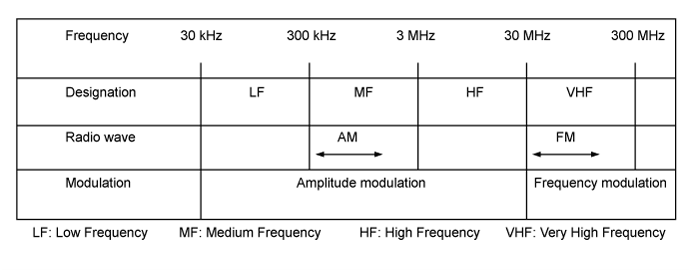
Service area

The service areas of AM and FM broadcasts are vastly different. Sometimes an AM broadcast can be received very clearly but an FM stereo broadcast cannot. FM stereo has the smallest service area, and is prone to pick up static and other types of interference such as noise.
| *a | FM (Stereo) |
| *b | FM (Monaural) |
| *c | AM |
Radio reception problems
- HINT:
- In addition to static, other problems such as "phasing", "multipath" and "fade out" exist. These problems are not caused by electrical noise, but by the radio signal propagation method itself.
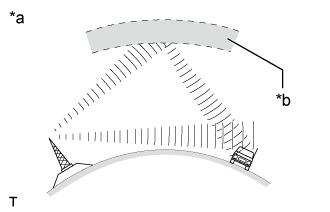
Phasing
AM broadcasts are susceptible to electrical interference and another kind of interference called phasing. Occurring only at night, phasing is the interference created when a vehicle receives 2 radio wave signals from the same transmitter. One signal is reflected off the ionosphere and the other signal is received directly from the transmitter.
| *a | Phasing |
| *b | Ionosphere |
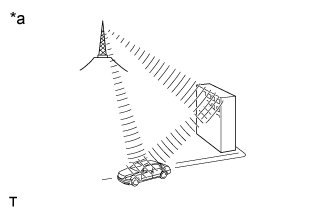
Multipath
Multipath is a type of interference created when a vehicle receives 2 radio wave signals from the same transmitter. One signal is reflected off buildings or mountains and the other signal is received directly from the transmitter.
| *a | Multipath |
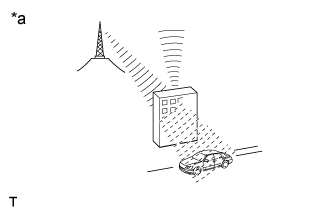
Fade out
Fade out is caused by objects (buildings, mountains and other such large obstacles) that deflect away part of a signal, resulting in a weaker signal when the object is between the transmitter and vehicle. High frequency radio waves, such as FM broadcasts, are easily deflected by obstructions. Low frequency radio waves, such as AM broadcasts, are less likely to deflect.
| *a | Fade Out |
Noise problem
Technicians must have a clear understanding about each customer's noise complaint. Use the following table to diagnose noise problems.
| Radio Frequency | Noise Occurrence Condition | Presumable Cause |
| AM | Noise occurs in a specific area | Foreign noise |
| Noise occurs when listening to an intermittent broadcast | An identical program transmitted from multiple towers can cause noise where the signals overlap | |
| Noise occurs only at night | Signal phasing | |
| FM | Noise occurs while driving in a specified area | Multipath resulting from a change in FM frequency |
| RDS-TMC FUNCTION OUTLINE (w/ RDS-TMC Function) |
This system has a function which allows the reception of traffic information from Radio Data System Traffic Message Channel (RDS-TMC) stations based on FM-multiple broadcasting. It assists the driver to avoid areas with traffic congestion. It also helps to improve traffic flow and road safety ().
| VEHICLE CUSTOMIZATION OUTLINE |
Customization of functions can be performed on the multi-display assembly screen. Refer to the owner's manual for further information on customizable items for the navigation system.
- HINT:
| CUSTOMIZE STARTUP IMAGE OR SCREEN OFF IMAGE FUNCTION OUTLINE |
An image can be copied from a USB device. The image can be used as the startup image or screen off image of the navigation system.
| ASL (Automatic Sound Levelizer) FUNCTION OUTLINE |
The Automatic Sound Levelizer (ASL) function automatically adjusts the audio system volume level in order to compensate for increased vehicle noise (vehicle noise tends to increase as vehicle speed increases). The ASL adjusts the volume level based upon vehicle speed signals that it receives from the combination meter assembly.